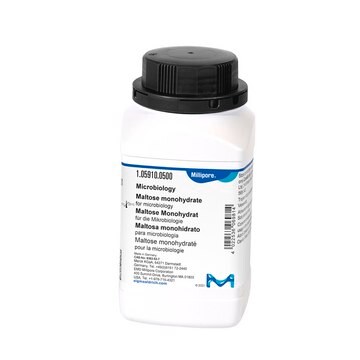Key Documents
M5895
D-(+)-Maltose monohydrate
≥98% (HPLC), BioReagent, suitable for cell culture, suitable for insect cell culture
Synonim(y):
4-O-α-D-Glucopyranosyl-D-glucose, Maltobiose
About This Item
Polecane produkty
pochodzenie biologiczne
potato
Poziom jakości
linia produktu
BioReagent
Próba
≥98% (HPLC)
Postać
powder
aktywność optyczna
[α]20/D 128.0 to 132.0 °, c = 4% (w/v) in water + trace NH4OH
metody
cell culture | insect: suitable
cell culture | mammalian: suitable
zanieczyszczenia
≤0.3% glucose
≤1.0% maltotriose
kolor
white
przydatny zakres pH
5.0-7 (25 °C, 180 g/L)
mp
102-103 °C
rozpuszczalność
H2O: 50 mg/mL
Zastosowanie
agriculture
temp. przechowywania
room temp
ciąg SMILES
O.OC[C@@H](O)[C@@H](O[C@H]1O[C@H](CO)[C@@H](O)[C@H](O)[C@H]1O)[C@H](O)[C@@H](O)C=O
InChI
1S/C12H22O11.H2O/c13-1-4(16)7(18)11(5(17)2-14)23-12-10(21)9(20)8(19)6(3-15)22-12;/h1,4-12,14-21H,2-3H2;1H2/t4-,5+,6+,7+,8+,9-,10+,11+,12+;/m0./s1
Klucz InChI
HBDJFVFTHLOSDW-DNDLZOGFSA-N
Szukasz podobnych produktów? Odwiedź Przewodnik dotyczący porównywania produktów
Opis ogólny
Zastosowanie
- Cell culture studies.
- Insect cell culture studies.
- To study the glass transition temperatures and phase relations for several saccharide-water systems.
- As medium supplement in the modified Luria-Bertani broth (LBM) medium for E. coli strains.
Inne uwagi
Kod klasy składowania
13 - Non Combustible Solids
Klasa zagrożenia wodnego (WGK)
WGK 1
Środki ochrony indywidualnej
Eyeshields, Gloves, type N95 (US)
Certyfikaty analizy (CoA)
Poszukaj Certyfikaty analizy (CoA), wpisując numer partii/serii produktów. Numery serii i partii można znaleźć na etykiecie produktu po słowach „seria” lub „partia”.
Masz już ten produkt?
Dokumenty związane z niedawno zakupionymi produktami zostały zamieszczone w Bibliotece dokumentów.
Klienci oglądali również te produkty
Nasz zespół naukowców ma doświadczenie we wszystkich obszarach badań, w tym w naukach przyrodniczych, materiałoznawstwie, syntezie chemicznej, chromatografii, analityce i wielu innych dziedzinach.
Skontaktuj się z zespołem ds. pomocy technicznej







